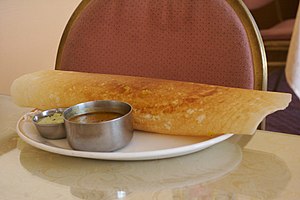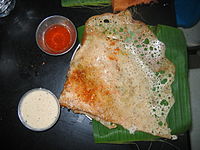Dosa (food): Difference between revisions
Reverting possible vandalism by Special:Contributions/76.223.243.249 to version by Sniperz11. If this is a mistake, report it. Thanks, ClueBot. (43360) (Bot) |
m robot Adding: te:దోసె |
||
| Line 102: | Line 102: | ||
[[es:Dosa]] |
[[es:Dosa]] |
||
[[fr:Dosa]] |
[[fr:Dosa]] |
||
| ⚫ | |||
[[ml:ദോശ]] |
[[ml:ദോശ]] |
||
| ⚫ | |||
[[pl:Dosa]] |
[[pl:Dosa]] |
||
[[ta:தோசை]] |
[[ta:தோசை]] |
||
[[te:దోసె]] |
|||
Revision as of 23:09, 2 November 2007

| |
| Dosa | |
|---|---|
| Kannada: | Dosay |
| Konkani: | Pollo (Devnagri:पॉळॉ) |
| Malayalam: | Dosha |
| Marathi: | Ghavan / Dheerda |
| Tamil: | Dosai (Tamil:தோசை) |
| Telugu: | Dosa / Minapattu |
The dosai, dosa, dose, thosai, or dhosa is a South Indian crêpe. This food, high in carbohydrates and proteins, is a typical South Indian breakfast item. The dish is also quite popular in many countries outside India.
Preparation

Regular dosa batter is made from lentils and rice blended with water and left to ferment overnight. (A modified form of the same batter can be used to make idlis. Characteristically, the rice in idli batter is coarsely ground and in dosa batter, the rice is very finely ground. Furthermore, the rice to lentil ratio varies in both.) The rice can be raw and/or parboiled. The lentils and rice can be replaced with highly refined wheat flour to make a maida dosa or semolina for a rava dosa.
The batter is then ladled in small amounts onto a hot greased skillet, where it is spread out into a thin circle and fried with oil or ghee until golden brown. The dosa may then be folded in half and served, or it may be flipped to cook on the other side and then served.
Serving methods
Though considered a breakfast dish, dosas are also eaten at other times of day. Those with wheat allergies or gluten intolerance will find the dosa a nice addition to their diets. They can be stuffed with vegetables, meats and sauces to create a quickly prepared meal.
The dosa is typically served with a side accompaniment which varies according to regional and personal preferences. More common side items include:
- sambar
- "wet" chutneys, often coconut chutney — a semi-solid paste usually made of coconut, dhal, green chilies, and mint or coriander(cilantro).
- "dry" chutney pudi or powder of spices and desiccated coconut
- Indian pickle
- milagai podi, a dry spice mixture
- chicken or mutton curry (commonly served in non-vegetarian households in Tamil Nadu)
- Curd with chilli powder topping
- Muddha Pappu(dal) with large amount of Ghee (This is traditional way of eating dosa in many parts of Andhra Pradesh)
Masala Dosa

A masala dosa is made by stuffing a dosa with a lightly cooked filling of potatoes, fried onions and spices, originating in Mysore. The King of Mysore hosted a big festival, after the festival there was a lot of food left over , he ordered his cook to think of somethig to make, so nothing is wasted. The cook came up with the brilliant idea of stuffing a plain Dosa with potatoes and spices.Hence originated the Masala Dosa.
One variant of the Masala dosa, the Mysore Masala Dosa, is served with both coconut and onion chutneys. In Bengalooru, the masala dosa is usually served with a red chutney applied to its inside surface. This peculiarity lends itself to a unique taste and is something that is not found elsewhere. The red chutney usually has generous amounts of garlic (traditionally garlic is not used in masala dosa especially in Brahmin community), and adds a nice flavor to the dosa when it is fried with ghee. In recent times this has become popular in other parts of Karnataka. Davanagere benne masala dose is another variant of the masala dosa from Karnataka. It is named after Davanagere in Karnataka. It is prepared by adding liberal doses of butter (benne) and also a potato filling (palya) that is unique. It is devoid mostly of any extra ingredients and is just mashed potato. The Rave dosa or Rava dosa is another variant that along with, Rave idly was popularised by Mavalli Tiffin Rooms of Bengalooru. Ragi dosa and Ade or Aday dosa are other variants that are native to Karnataka.
Dosa variations

Other types of dosa include:
- Egg Dosa - a dosa spread with an omelette.
- Chilli Dosa - idli powder is spread on the dosa.
- Onion Dosa - chopped and sautéd onions are spread on the dosa.
- Ghee (thuppa/neyyi) dosa - ghee is used instead of oil while frying the dosa.
- Butter Dosa - butter is used instead of oil while frying dosa and a small amount on top of it while serving.
- Roast - the dosa is spread thinly and fried until crisp.
- Family Roast - a long dosa which can be spread over 2 or 3 feet.
- Paper Dosa - a long and very thin delicate dosa which can be spread over 2 feet.
- Green Dosa - a dosa stuffed with fresh vegetables and mint chutney.
- Chow-Chow Dosa - a dosa stuffed with (Indian flavored) Chinese noodles.
- Cheese Dosa - a dosa stuffed with cheese.
- Masala Dosa - a long thin dosa made with different spices, which can also be spread over 2 feet.

Though dosai typically refers to the version made with rice and lentils, many other versions of dosai exist and are popular in varying degrees. This is sometimes specific to a region in India. Some common ones are:
- Rava dosay - made with rava or semolina, which doesn't need fermentation and is usually considered a fast snack/tiffin.
- Wheat Dosai - made with wheat flour, and served with coconut chutney.
- Vella Dosai - a sweet dosai made of jaggery[citation needed], with ghee/neyyi.
- Ragi dosay - made of ragi or millet flour, usually considered "a poor man's fare".
- Muttai dosai - eggs are added to the regular batter; the word muttai in Tamil means "egg".
- Set Dose - a popular type of dosa in Karnataka, which is cooked only on one side and is served in a set of two, hence the name.
- Neer dosa - a dosa prepared from rice unique to Dakshina Kannada and Uttara Kannada districts.
- Pesarattu - a dosa prepared from moong dal; Andhra special .
Media
Template:Multi-video start Template:Multi-video item Template:Multi-video end
Spelling
There are various ways to transliterating dosa: dhosa (used by Hindi speaking people), dosay, dosai, dhosai, tosai, thosai (used in Malaysia and Singapore).
